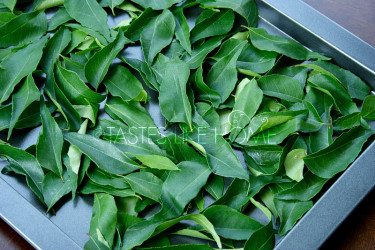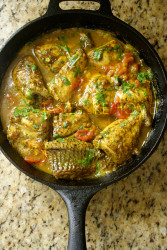Hi Everyone, Years ago, on an occasion just like this – Valentine’s – I publicly declared my love for curry. It is a love affair that started when I was a young child. Decades later, that love is stronger than ever, and just like how couples who have been together for a long time still do not know everything about each other and constantly surprise the other, so too is it with me and curry.
There are some dishes that have courted me heavily such as the Vietnamese beef noodle soup, Pho, and squid (calamari), cooked any which way. And though they have a special place in my life, it is curry that will forever reside in my heart.
 Growing up, if my mother made the ‘mistake’ of asking me what to cook the answer was always the same – curry. It didn’t matter if it was meat, seafood or vegetable, the answer was always curry. Sometimes as soon as the question escaped her lips she’d quickly add, “I ain’t cooking no curry.” Just as I typed that comment, I thanked the heavens that I am now an adult and therefore if I want to eat curry I can do so at any time. It seems that my nephew Ethan shares my love for curry too. Whenever his mom asks him what he would like to eat or what she should cook, there is always that one-word answer, “curry”. And just like our mother, Ethan’s mom (my sister), expresses a similar sentiment, “Gosh Ethan, I tired eating curry.” One day she threatened him that she would send him to live with me so that together we could eat curry every day. If I were Ethan, I’d think of that more as a promise rather than a threat.
Growing up, if my mother made the ‘mistake’ of asking me what to cook the answer was always the same – curry. It didn’t matter if it was meat, seafood or vegetable, the answer was always curry. Sometimes as soon as the question escaped her lips she’d quickly add, “I ain’t cooking no curry.” Just as I typed that comment, I thanked the heavens that I am now an adult and therefore if I want to eat curry I can do so at any time. It seems that my nephew Ethan shares my love for curry too. Whenever his mom asks him what he would like to eat or what she should cook, there is always that one-word answer, “curry”. And just like our mother, Ethan’s mom (my sister), expresses a similar sentiment, “Gosh Ethan, I tired eating curry.” One day she threatened him that she would send him to live with me so that together we could eat curry every day. If I were Ethan, I’d think of that more as a promise rather than a threat.
There are all sorts of curries the world over and I do not mean this in terms of a particular ingredient, rather, curry as made and known by certain countries and regions with their signature flavours. Places like Jamaica, Trinidad & Tobago, Suriname and St Vincent are among the countries in the region that are known for their tasty curries. In India, there are north and south Indian curries that include regional curries within these areas that draw influence from places such as Portugal, Persia (modern day Iran), and parts of the Middle East. Thailand, Malaysia and Indonesia too are countries that are well known for their multifarious curries. While no one can really claim to have had all the types of curries out there, I have had a few, and while they were all excellent in their own right, I prefer a Guyanese curry. Perhaps it is not exclusively the spice blend that makes our curry stand out but the sweet hands that artfully and skillfully cook the curry.

For the past 17 years I have been experimenting with various spice/masala blends to make curry. It continues to be such a pleasurable and enjoyable experience. With each combination and on each occasion, the curry reveals various aspects of itself. In addition to varying the spice blends, I have a few aromatic staples that are present in each curry – ginger, garlic and cilantro/fresh coriander. Onions, lemongrass, fresh lime leaves, bay leaves, and curry leaves (kariveppilai/kari patta) also find their way into some of my curry pastes depending on the main ingredient that I am currying. Fresh and toasted coconuts, raw and toasted peanuts as well as sesame seeds also make appearances based on the type of curry I am making. It is no idle boast when I tell you that no two curries are the same at my home. For me it is a constant learning experience so I am always changing things up. As I said in the beginning, curry and I are always surprising each other.
I did away with curry powder a long time ago because I found it bland. Even when growing up, the women in my family only used it (curry powder) to give colour to the curry. They would toast and grind spices each time they made curry along with pepper, onions, garlic, and sometimes celery and add the mixture to the curry powder. I use pure dried ground turmeric and fresh turmeric, which is easily available here in Barbados. The flavour and colour that the fresh turmeric gives, compared to the dried ground version, is different – the colour is brighter and the taste has subtle hints of citrus. Good stuff.

Spicing, just like the seasoning of food, is an art learned, eventually we tailor things to suit our taste and that is essentially what my curry-spice-blending is all about. I’d like to encourage you, if you are interested, to try experimenting too. Actually, we don’t even have to look far for different curry flavour variations. I have often heard people say, there is nothing like a Corentyne curry or an Essequibo curry. And that statement mostly comes down to the spice mix. I’ve known relatives and friends (meaning no disrespect) who would bring garam masala for my mom and aunts when they come to town.
What I have found through my spice blending for curries is that certain ingredients require a more robust combination of spices, while with others restraint is necessary. Sometimes it is not so much about the spices playing the key role, rather, it is letting the other aromatics such as ginger, lemongrass or cilantro shine, or, having the flavour of the ingredient itself do the work.
Cinnamon, star anise, cumin (geera), cloves, cardamom (elaichi) and ginger easily play dominant roles in curry making the dish really stand out. On the other hand, aromatics such as lemongrass, curry leaves, ginger-garlic paste, and fresh coriander/cilantro, even tomatoes find a place of prominence in curries.
I’ll close here now, wishing you a love-filled weekend. I have a date with a karahi full of curry, what kind, it matters not.
Cynthia




